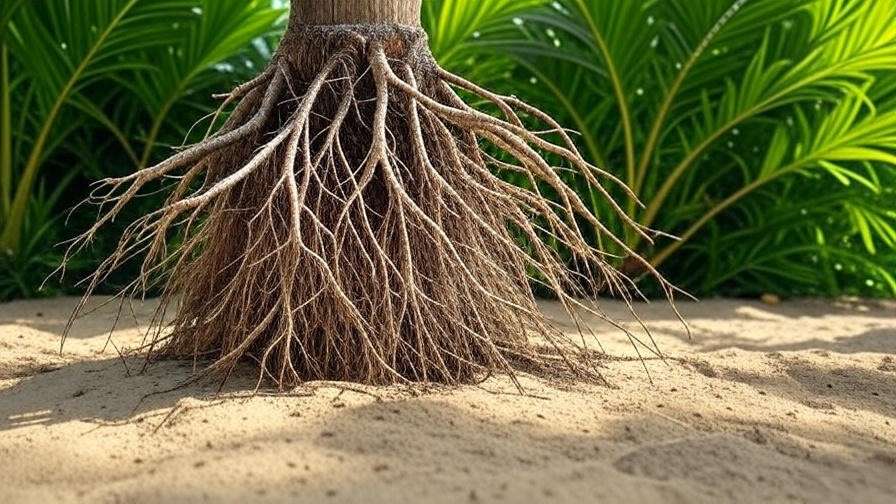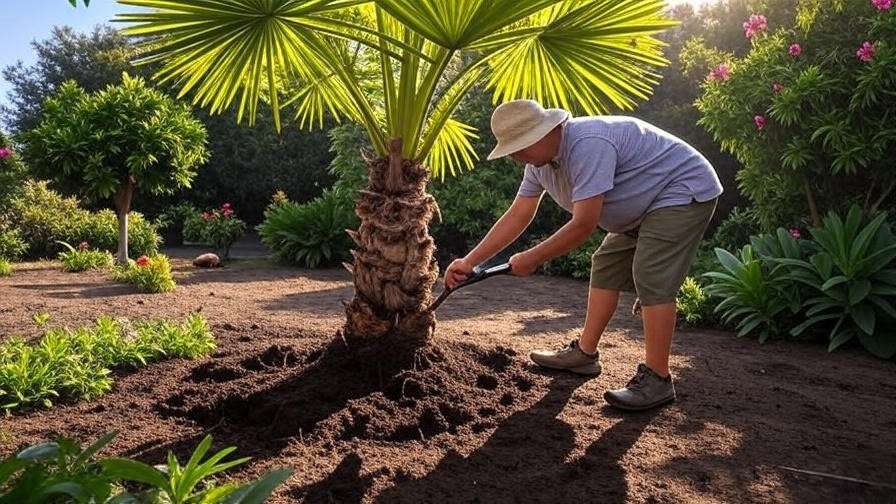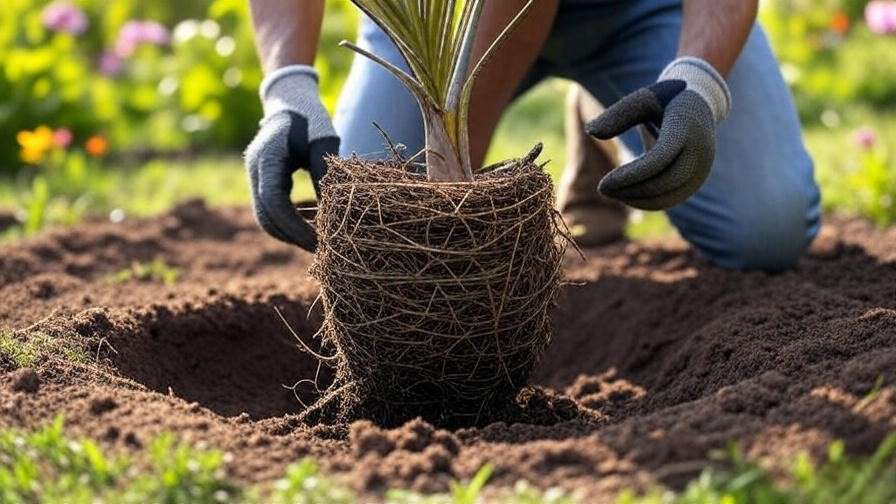Picture this: your majestic palm tree, swaying gracefully in your backyard, suddenly starts to lean, its fronds yellowing despite your best efforts. The culprit? Often, it’s the often-overlooked root system for palm trees. These intricate networks beneath the soil are the lifeline of your palm, anchoring it, absorbing nutrients, and ensuring its vibrant growth. Yet, many homeowners and gardeners misunderstand how palm roots work, leading to costly mistakes. In this comprehensive guide, we’ll unravel the mysteries of palm tree root systems, debunk myths, and share expert-backed care tips to keep your palms thriving for years. Whether you’re planting a new palm or nurturing an established one, this article is your roadmap to healthy roots and flourishing trees. 🌞
H2: The Unique Nature of the Root System for Palm Trees 🌱
H3: What Makes Palm Tree Roots Different?
Unlike the deep taproots of oaks or maples, palm trees boast a fibrous root system, a dense, web-like network that spreads horizontally near the soil surface. This unique structure makes palms both resilient and vulnerable. According to Dr. Susan Steinberg, a horticulturist at the University of Florida’s Extension Service, “Palm roots are non-invasive but highly sensitive to environmental changes, making proper care essential for stability and growth.”
For example, the coconut palm (Cocos nucifera) develops a shallow, spreading root system that can extend 10-15 feet outward, while the date palm (Phoenix dactylifera) forms a slightly deeper but still compact root ball. This fibrous structure allows palms to anchor in sandy or loose soils, common in tropical regions, but it also means they rely heavily on consistent care to avoid stress.

H3: How Palm Roots Function for Growth and Stability
Palm roots serve three critical functions: anchoring, nutrient absorption, and water uptake. The fibrous system creates a broad base that stabilizes the tall, slender trunks of palms, even in windy conditions. However, their shallow nature means they’re less effective at reaching deep water sources, making proper irrigation crucial.
Environmental factors like soil type and climate significantly influence root development. Sandy soils, for instance, promote wider root spread, while clay soils may restrict growth, leading to weaker palms. Think of palm roots as a sponge: they soak up water and nutrients efficiently but can become oversaturated or starved without the right balance. 💧
Tip: Visualize palm roots as a wide, shallow web. To support this structure, ensure your soil is loose and well-draining to encourage healthy expansion.
H2: Factors Influencing Palm Tree Root Health 🌞
H3: Soil Conditions and Their Impact
The foundation of a healthy root system starts with the soil. Palms thrive in well-draining, loamy soils with a pH between 6.0 and 7.5. Compacted or clay-heavy soils can suffocate roots, limiting oxygen and nutrient uptake. Conversely, overly sandy soils may drain too quickly, leaving roots parched.
To optimize soil conditions, test your soil’s pH and nutrient levels annually. Kits are available at garden centers, or you can consult a local extension service. If your soil is compacted, consider aerating it gently around the root zone to improve airflow. Expert Tip: Mix organic matter like compost into the top 6-12 inches of soil to enhance drainage and fertility.

H3: Watering Practices for Optimal Root Growth 💧
Watering is a delicate balance for palm roots. Too much water can lead to root rot, while too little causes dehydration. Most palms need 1-2 inches of water per week, depending on climate and species. For example, fan palms (Washingtonia spp.) tolerate drier conditions, while royal palms (Roystonea regia) prefer consistently moist soil.
To water effectively:
- Water deeply but infrequently to encourage root spread.
- Use a soaker hose or drip irrigation to target the root zone (6-12 inches from the trunk).
- Avoid overhead watering, which can promote fungal growth.
Case Study: A homeowner in Miami noticed their sabal palm wilting despite regular watering. After consulting an arborist, they discovered poor drainage was causing root rot. Installing a French drain and adjusting watering habits revived the palm within months.
H3: Climate and Environmental Considerations
Climate plays a pivotal role in root health. Tropical climates with high humidity support lush root growth, while arid regions require supplemental irrigation. Strong winds, common in coastal areas, can stress shallow roots, so staking young palms is often necessary.
In colder climates, protect roots from frost by applying a 2-4 inch layer of mulch around the base, keeping it 6 inches away from the trunk to prevent rot. Tip: Use organic mulch like bark or wood chips to regulate soil temperature and retain moisture. 🌍
H2: Common Problems with Palm Tree Root Systems and Solutions 🛠️
H3: Root Rot and Fungal Infections
Root rot, often caused by fungi like Phytophthora, is a leading threat to palm roots. Symptoms include yellowing fronds, stunted growth, and a foul odor near the base. Overwatering and poor drainage are the primary culprits.
Prevention Strategies:
- Ensure proper drainage by planting in raised beds or amending soil with sand.
- Water only when the top 2 inches of soil are dry.
- Apply a fungicide labeled for palms if early signs of rot appear.
Expert Solution: For mild cases, remove affected roots with sterilized tools and treat with a copper-based fungicide. For severe cases, consult an arborist to assess if the palm can be saved.

H3: Nutrient Deficiencies and Root Health
Healthy roots are critical for nutrient uptake, but deficiencies in potassium, magnesium, or nitrogen can weaken palms. Symptoms include yellowing or browning fronds and slow growth. A palm-specific fertilizer (e.g., 8-2-12 NPK ratio) applied 2-3 times per year can address these issues.
Fertilization Guide:
- Apply granular fertilizer evenly around the root zone, 6-12 inches from the trunk.
- Water thoroughly after application to help nutrients reach the roots.
- Avoid over-fertilizing, which can burn roots.
Success Story: A gardener in Arizona revived a nutrient-deficient queen palm by applying a slow-release palm fertilizer and magnesium sulfate, restoring vibrant green fronds in one growing season.
H3: Transplant Shock and Root Damage
Transplanting palms is tricky due to their sensitive root systems. Improper handling can lead to transplant shock, causing wilting or leaf drop. To minimize stress:
- Dig a root ball at least 12-18 inches wide and deep.
- Keep the root ball intact and moist during transport.
- Plant at the same depth as the original location.
- Water daily for the first 2 weeks, then taper off.
Checklist: Before transplanting, prepare the new site with well-draining soil, stake the palm for stability, and monitor for signs of stress (e.g., wilting fronds).
H2: Best Practices for Caring for Palm Tree Roots 🌴
H3: Planting Palm Trees for Root Success
Proper planting sets the stage for healthy roots. Follow these steps:
- Choose the Right Spot: Ensure full sun or partial shade, depending on the species.
- Dig the Hole: Make it twice as wide and as deep as the root ball.
- Amend Soil: Mix in compost or sand for drainage.
- Plant and Water: Place the palm at the original soil line, backfill, and water thoroughly.
For multi-palm landscapes, space trees 10-15 feet apart to prevent root competition. Expert Insight: The International Society of Arboriculture recommends planting palms in spring or early summer for optimal root establishment.

H3: Maintenance Tips for Long-Term Root Health
Regular maintenance keeps roots thriving:
- Inspect Roots: Check for exposed or damaged roots annually, especially after storms.
- Remove Debris: Clear fallen fronds or mulch buildup to prevent fungal growth.
- Aerate Soil: Use a garden fork to gently loosen compacted soil around the root zone.
Tip: Avoid heavy machinery near palms, as it can compact soil and damage roots.
H3: Protecting Roots in Extreme Conditions
Extreme weather poses risks to palm roots. During storms, brace young palms with stakes to prevent uprooting. In drought, increase watering frequency but avoid waterlogging. For frost, wrap the trunk and cover the root zone with mulch or frost cloth.
Case Study: A coastal California gardener saved their windmill palm during a rare freeze by mulching heavily and wrapping the trunk, preserving root health and preventing dieback.
H2: Myth-Busting: Common Misconceptions About Palm Tree Roots 🕵️♀️
Palm tree root systems are often misunderstood, leading to poor care practices that can harm these iconic trees. Let’s debunk some common myths with evidence-based insights to ensure you’re equipped with accurate knowledge for nurturing your palms.
- Myth 1: Palm roots are invasive and damage structures. Contrary to popular belief, palm roots are non-invasive. Their fibrous nature means they spread horizontally rather than penetrating deeply like taproots. A 2019 study by the University of California Cooperative Extension confirms that palm roots rarely damage foundations or pipes unless planted too close to structures. Solution: Plant palms at least 6-8 feet from buildings or utilities to avoid any risk.
- Myth 2: Palms don’t need deep soil. While palm roots are shallow, they still require well-prepared soil to thrive. Compacted or nutrient-poor soil can stunt root growth, leading to weak trees. Solution: Prepare a planting site with loose, fertile soil at least 18 inches deep to support healthy root development.
- Myth 3: Palm roots can’t handle drought. Many palm species, like the date palm, are drought-tolerant once established, thanks to their efficient fibrous roots. However, young palms need consistent moisture to develop strong roots. Solution: Water newly planted palms regularly for the first 6-12 months, then reduce frequency as they mature.
Expert Insight: Dr. James Downer, a palm specialist at UC Davis, notes, “Misconceptions about palm roots often lead to overwatering or poor planting practices. Understanding their unique structure is key to successful care.” By debunking these myths, you can make informed decisions to keep your palm’s root system thriving. 🌱
H2: Choosing the Right Palm Species for Your Environment 🌍
Selecting a palm species suited to your climate and soil conditions is crucial for root health and overall growth. Different palms have varying root system traits, affecting their adaptability to specific environments. Below is a comparison of five popular palm species to guide your choice:
| Palm Species | Root System Traits | Ideal Climate | Soil Preference |
|---|---|---|---|
| Coconut Palm | Wide-spreading, shallow (6-12 inches) | Tropical, humid | Sandy, well-draining |
| Date Palm | Moderately deep, fibrous (12-18 inches) | Arid, hot | Loamy, slightly alkaline |
| Fan Palm | Shallow, dense (8-12 inches) | Warm, semi-arid | Well-draining, sandy |
| Royal Palm | Shallow, sensitive to waterlogging | Tropical, wet | Rich, loamy |
| Pygmy Date Palm | Compact, shallow (6-10 inches) | Subtropical, mild | Well-draining, fertile |
Choosing Wisely: For small gardens, opt for compact species like the pygmy date palm, which has a minimal root spread, making it ideal for confined spaces. In contrast, royal palms need ample space and consistent moisture to support their sensitive roots. Tip: Consult your local nursery or extension service to match palm species to your region’s climate and soil type.
H2: Advanced Care: Monitoring and Enhancing Root Systems 🔍
H3: Using Technology to Monitor Root Health
Advanced tools can elevate your palm care game by providing insights into root health. Soil moisture meters help determine if your palm is getting the right amount of water, preventing over- or under-watering. For professional-grade assessments, arborists use ground-penetrating radar or root imaging to visualize root spread and detect issues like rot or compaction without digging.
Case Study: A botanical garden in Florida used a soil moisture meter to diagnose uneven watering in a sabal palm grove. Adjusting irrigation based on the readings restored root health and revived the trees within a season.

H3: Boosting Root Growth with Amendments
Organic amendments can significantly enhance root vitality. Compost adds nutrients and improves soil structure, while mycorrhizal fungi form symbiotic relationships with roots, boosting nutrient uptake. To apply:
- Spread 2-3 inches of compost around the root zone annually.
- Mix mycorrhizal inoculant into the soil during planting or as a top-dressing for established palms.
- Avoid chemical-heavy amendments, which can burn sensitive roots.
DIY Recipe: Create a palm-friendly soil mix by combining 50% compost, 30% sand, and 20% native soil. Apply this mix around the root zone to promote aeration and drainage. Expert Tip: Always water thoroughly after applying amendments to help nutrients penetrate the soil. 🌿
H2: FAQs About Palm Tree Root Systems ❓
- How deep do palm tree roots grow?
Most palm roots stay within 12-36 inches of the soil surface, spreading outward rather than downward. Depth varies by species, with date palms reaching slightly deeper than coconut palms. - Can palm roots damage my foundation?
Palm roots are non-invasive and rarely damage structures if planted at least 6-8 feet away from foundations or pipes. Proper spacing is key. - How often should I water my palm to support its roots?
Water young palms 2-3 times per week (1-2 inches) for the first 6 months. Established palms need watering once a week, depending on climate and soil drainage. - What are signs of an unhealthy root system?
Look for yellowing fronds, wilting, slow growth, or a leaning trunk. These may indicate root rot, nutrient deficiency, or transplant shock. - Can I plant palms near other trees?
Yes, but space them 10-15 feet apart to prevent root competition. Smaller palms like pygmy date palms are ideal for mixed landscapes. - How can I protect palm roots during a storm?
Stake young palms and apply mulch to stabilize the root zone. Avoid overwatering before storms to prevent waterlogged roots. - Do palm roots need special fertilizers?
Use a palm-specific fertilizer (e.g., 8-2-12 NPK) to address common deficiencies like potassium or magnesium, which directly affect root health.
H2: Conclusion: Nurturing Healthy Palm Tree Roots for Vibrant Growth 🌿
The root system for palm trees is the unsung hero behind their towering beauty and resilience. By understanding their unique fibrous structure, addressing common issues like root rot or nutrient deficiencies, and adopting expert-backed care practices, you can ensure your palms thrive for decades. From choosing the right species to monitoring soil health with advanced tools, every step you take strengthens your palm’s foundation. Apply these tips, share your palm care journey in the comments, and watch your trees flourish with vibrant, healthy roots! 🌴
Call-to-Action: Download our free “Palm Tree Root Care Checklist” to keep your palms in top shape. Have a question or success story? Drop it below—we’d love to hear from you!













